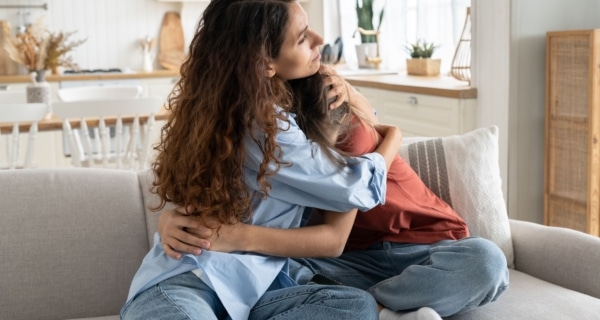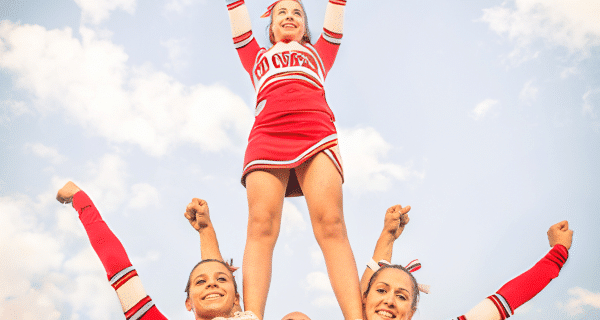Gymnastics is a sport of power, precision, and poise – a delicate balance of strength and agility where every vault, flip, and landing matters. For gymnasts with scoliosis, a condition marked by a lateral spinal curvature exceeding 10 degrees (with rotation), this balance faces unique hurdles.
Often surfacing during the pre-teen or teen years – peak gymnastics training time – scoliosis doesn’t end a career, but it shifts the dynamics. It impacts flexibility, stability, and endurance in ways every gymnast, coach, and parent should understand. Here’s how scoliosis influences gymnastics, and how to navigate it effectively.
The Physical Impact
Scoliosis reshapes the spine, sending ripples through a gymnast’s body. Flexibility, vital for gymnastics, can be impacted as the asymmetries that impact the trunk start to take hold. A 30-degree thoracic curve will change the shape of the trunk, causing one side to be more prominent and the other side to collapse more. This can make backbends or splits lopsided, particularly if hip heights are uneven or there is rotation within the pelvis too. A gymnast could struggle to arch fully on the beam or extend evenly in a layout, as the spine resists uniform motion.
Stability also falters. The curve’s asymmetry shifts the body’s alignment, tilting the pelvis or shoulders. A gymnast with a lumbar curve might wobble in handstands or struggle with a steady dismount (Fig 1), as the uneven foundation disrupts balance. Endurance can take a hit too – a distorted rib cage can limit breathing, particularly in large curves, which may impact stamina during a performance. These aren’t career-killers, but they demand awareness and adjustment.
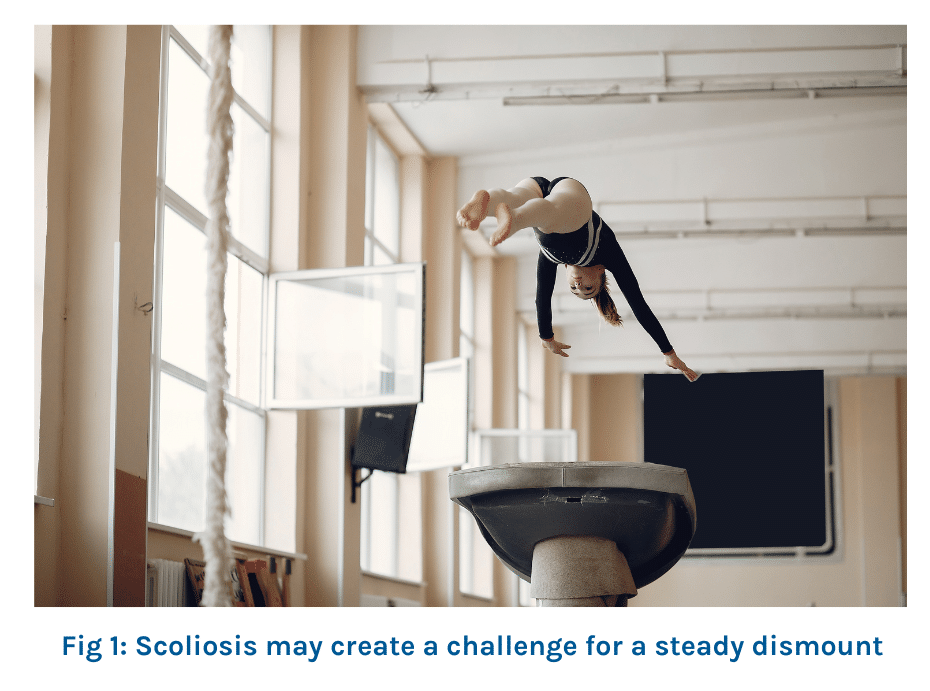
The Mental Game
Scoliosis doesn’t just bend the body, it can also test the mind. Gymnastics thrives on confidence, yet a visible curve – like a rib hump in a leotard – can spark self-doubt. A young gymnast might hesitate before a vault or avoid team photos, feeling their shape stands out awkwardly. In a sport where judges eye every detail, this can weigh heavily.
Discomfort adds another layer. While not universal, some gymnasts with scoliosis feel aches after intense practice. This can sap focus, turning a joyful flip into a grind. Coaches and parents should catch these subtle signs – a hesitation or a wince – before they affect motivation.
Back ache is not normal for scoliosis. If pain turns up, make sure your gymnast is checked out by a Scoliosis trained health professional.
Performance on the Mat
How does this play out in competition? A gymnast with a mild 15-degree curve might shine with minor tweaks, like extra exercises during their scoliosis specific exercise program (ScoliBalance). But for moderate (25–40 degrees) or severe (over 40 degrees) curves, challenges mount. This usually requires an intense ScoliBalance program combined with a 3D custom brace. A vault might veer off-center, or a tumbling pass might lose height if asymmetry throws off momentum. On bars, uneven shoulders could skew a giant swing, while beam routines might falter under an unstable base.
Yet scoliosis doesn’t crush potential. Gymnasts can excel with the right approach, it just starts with early action and tailored support.
Strategies for Gymnasts
Gymnasts with scoliosis can adapt and soar with practical steps, but they will need a health professional trained in Scoliosis management to work collaboratively with the Coach and vice versa:
- Use ScoliBalance: ScoliBalance is delivered by a Scoliosis Rehabilitation Therapist who can train the gymnast to correct their posture in 3D. The home program can be developed to be gymnastics specific too, in that the gymnast will be taught to apply their active self corrections in their gymnastics training.
- 3D Custom Bracing: If prescribed a brace, the gymnast will need to stick to wear times but adjust for training. The brace does not have to be worn during training, however each moment out of brace means the spine is not supported. A 3D custom made brace will be unique to each gymnast. They will likely need to be wearing the brace when they are not at training. Their Scoliosis Clinician will determine this based on the risks of progression for each curve presentation.
- Tune In: Rest when discomfort spikes, pushing past it risks exhaustion.
Tips for Coaches
Coaches shape how scoliosis unfolds in the gym:
- Watch Closely: Spot uneven hips, a tilted head, or one-sided strain. Early clues lead to quicker fixes.
- Tweak Routines: Adjust moves, like softening a back handspring (Fig 2) to ease spinal stress, without spotlighting the gymnast.
- Sync with Bracing Plans: Coordinate with parents on brace wear schedules or rest days. Flexibility keeps gymnasts in the game.
Build a Team Vibe: Foster support with group warm-ups or buddy checks, so differences don’t dim spirit.
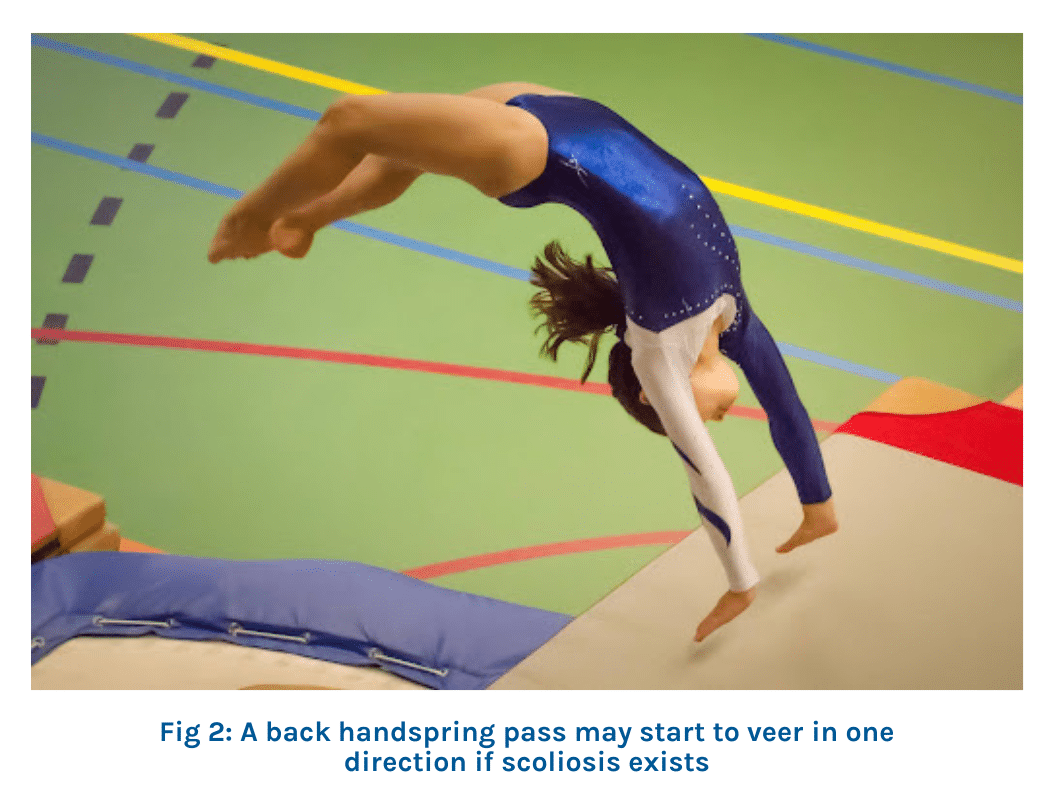
Guidance for Parents
Parents anchor a gymnast’s scoliosis journey:
- Check Early: Look for curves around 10–12 years, when scoliosis often appears, particularly in girls, but it occurs in boys too! A quick forward bend test at home can prompt a doctor’s visit (Fig 3).
- Find Experts: Team up with a scoliosis specialist for bracing or scoliosis-specific rehabilitation advice. Early steps shift outcomes.
- Lift Spirits: Validate feelings about treatment orbody changes.
- Balance Goals: Work with coaches to prioritise spine health over perfection.
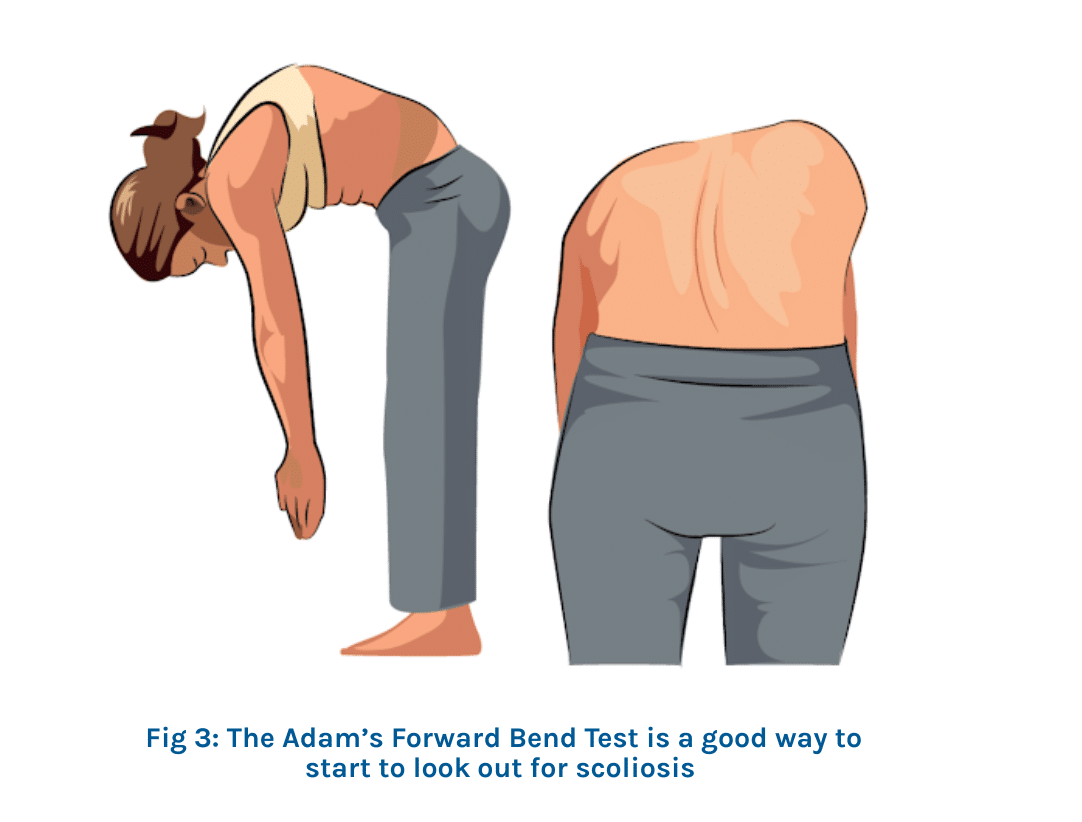



#StrongSpinesStrongFutures

